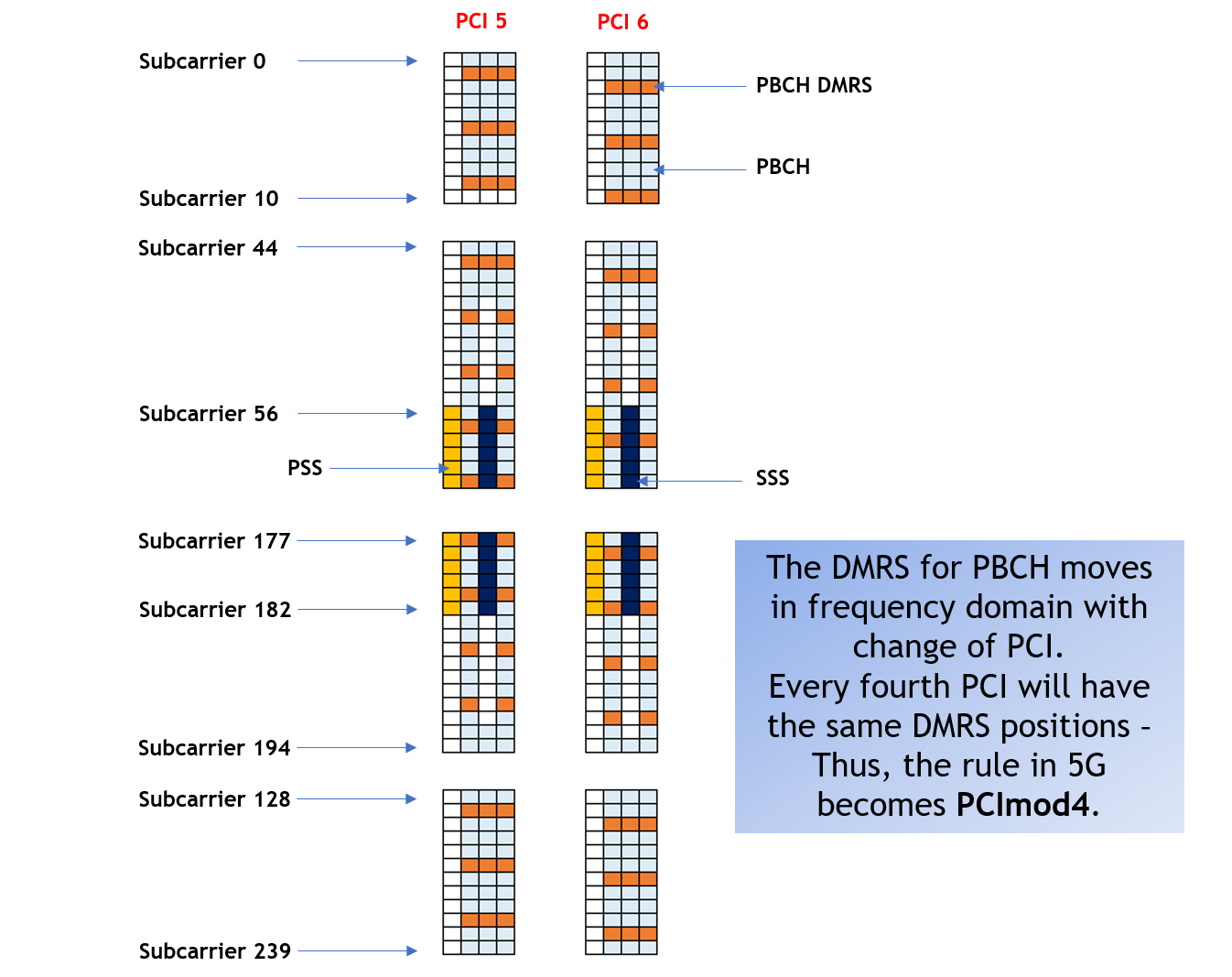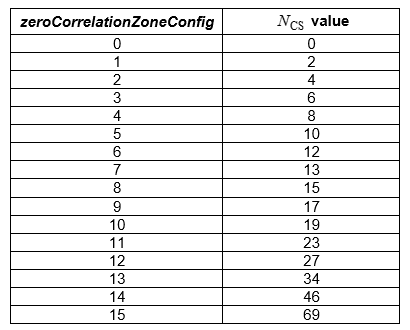In this article, “5G RF Design and Planning Fundamentals” I will try to explain the basic planning principles for 5G in comparison to its predecessor (LTE). I remember that during the introduction of LTE, it took quite some time for everyone to understand its planning and design procedures so I will try to explain the fundamental steps required to plan a 5G network enabling everyone to develop an understanding of the 5G network design.
Like LTE, the 5G network requires a PCI, RACH and TAC plan. The process differs slightly due to the changes in the RF structure. There is an additional dimension in 5G which is related to massive MIMO or beam-forming. There might be scenarios where the beam-forming configuration will be designed as well but we will discuss that later.
PCI Planning:
As we are all aware, there are 504 PCIs in LTE that are used to plan the 4G network that I explained in my previous article, PCI Planning: Facts & Myths. The PCI itself is made up of PSS and SSS, where PSS has three values (0 to 3) while the SSS has 168 values (0 to 167). The structure of the 4G PCI is based on the following equation.
PCI = (3 x SSS) + PSS
This means that if the PCI value is 10, then the SSS is 3 and PSS is 1 (3 x 3 + 1 = 10). In 5G, the basic structure of the PSS is same as LTE but the number of SSS has increased. The total number of SSS in 5G is 336 (0 to 335) while the PSS count is still 3 (0 to 2). This means that the maximum PCI count for 5G would be 1008 (0 to 1007)
Total 5G PCI Count = (3 x 335) + 2 = 1007
Ofcourse, the first rule is similar to 4G which is to ensure that the same PCI is not re-used within close proximity. This is required to avoid PCI conflicts and confusions. However, the second rule differs slightly then the one in 4G.
PCI-mod-3 & PCI-mod-4: As explained in my previous article on PCI Planning in 4G, every third PCI has the same Reference Signal position in frequency domain and causes interference between them. So, PCI mod-3 should not be used in overlapping cells. However, in case of 5G, there are some differences. Firstly, 5G does not have CRS which means that it does not send Reference Signals all across the bandwidth like 4G so that removes the chances of interference between reference signals and it also removes the high constant noise created by reference signals. Secondly, 5G only uses DMRS in PBCH and these follow PCI mod-4 rule which means that every 4th PCI has the same location for PBCH DMRS in the frequency domain. Thus, the rule for 5G changes to PCI mod-4.
However, since 5G only has 3 PSS like LTE, so every third PCI will have the same PSS value. This can cause interference on the PSS so PCI mod-3 cannot be totally ignored. Having said that, the same PSS will not cause a KPI impact but might delay the synchronization. I believe that this issue would be suppressed if the beam-forming is used for the SSB which should be the case in most of the initial 5G trials.

The figure above shows the relation between PCI and PBCH DMRS. There is another difference in the concept of LTE’s PCI mod-3 and 5G’s PCI mod-4. In LTE, the CRS are all over the bandwidth and they follow the PCI mod-3 rule but in case of 5G, the DMRS are only inside the PBCH. This means that even if the two neighboring cells follow PCI mod-4 rule, the DMRS of one cell will still be overlapped with the PBCH data of the second cell as the PBCH will always be present. So, the gain of following the PCI mod-4 rule might not be that much although it will have some gain considering that the structure of DMRS and PBCH is different.
In short, the PCI mod-3 and PCI mod-4 should be followed for initial planning of the network.
RACH Planning:
The RACH planning concept is pretty much similar for both 4G and 5G but the Ncs tables have changed and some new preamble formats have been introduced. In 5G, there are two groups of preambles
- Long Preamble Formats : These are format 0, 1, 2 and 3 with length of 839
- Short Preamble Formats : These are formats A1, A2, A3, B1, B2, B3, B4, C0, C2 with length of 139
Long preamble formats will have more overhead but it will have a bigger cell radius while the short formats will have a lower overhead but also a smaller cell radius. The Ncs values can be seen in 3GPP-38.211 under 6.3.3 which describes the PRACH. As an example, lets take a short preamble so this will take us to the Ncs table 6.3.3.1-7

So, now if I choose a cell radius of 3 km for the cell, then using multipath delay spread of 2 microseconds, the corresponding Ncs value 2 will be around 45. This will map to the next Ncs value of 46 in the table which means that root sequence will have a cyclic shift of 46 to generate next preamble. The length of the short preamble is 139 so the number of preambles that can be generated by each root sequence will be
Number of Preambles Per Root Sequence = Floor(139/46) = 3
As we need 64 preambles per cell so the number of root sequences required to generate 64 preambles will be
Number of Root Sequences Required For 64 Preambles = Ceil(64/3) = 22
This means that the RACH plan will be made such that the first cell uses root sequences from 0 to 21 while the second cell will use 22 to 43 and so on. These are the basics for the RACH design and we can use the above method to generate RACH plans for different scenarios.
TAC Planning:
The TAC or TAL planning for 5G is similar to 4G. Infact, as the current 5G NR will be using the NSA mode, so initially it should be using the same TAC or TAL as the 4G network. However, the principles for TAC planning are same as given below
- The paging load should be calculated to ensure that the TAC is not so big that the paging overhead gets too high. This issue is usually mitigated with the intelligent/dynamic/precise paging features
- If the TAC is too small, this will result in a lot of TAUs that can generate signaling overheads. This can be handled by intelligent TAL planning or even user specific dynamic TAL assignments.
I hope this article helps in understanding the 5G NR planning and design fundamentals.
I am leaving you with a short bonus video that explains a 5G handset works with different 5G deployment modes (NSA vs SA) and what are the pros and cons of each type of 5G deployment architecture. It also describes how a 5G handset will get service in each scenario and why one scenario is preferred over the other by the Global Operators. Please let me know if you have any questions.
Also, if this has been helpful, then please subscribe to our Youtube channel – Our Technology Planet for more exciting stuff and videos.
5G Architecture – A Summary of 5G Network Deployment Options
Ali Khalid
Latest posts by Ali Khalid (see all)
- 5G SA Cell Search & Network Entry Matrix - July 18, 2023
- Top 5G Interview Question – 5G RACH Process - July 10, 2023
- 5G RSRP RSRQ SINR Conversion Mapping - June 30, 2023

Hi, can we assign same PRACH Config Index to neighbor cells? and if not then why? which KPI will be affected if there are PRACH Config Index clashes in the network.
Hello Rao,
Thank you for your comment.
Please follow the link below and post your question/feedback in Youtube comments section so that Ali Khalid will be able to answer.
https://youtu.be/sbfsS4NylE0 – 5G Design & Planning
Hello Ali,
I have two questions:
1.
“This means that the RACH plan will be made such that the first cell uses root sequences from 0 to 21 while the second cell will use 22 to 43 and so on. These are the basics for the RACH design and we can use the above method to generate RACH plans for different scenarios.”
So if I use this strategy for one SITE does this mean that for another site we can use the RSI 1 to 22 and second sector 2 to 44 etc?
2.Why do we need 64 Preambles per cell? How did you got this value?
Thank you
can you please explain how you calculated Ncs 45.
Great article Ali.
Precisely defined for good understanding . Please are you going to put out an article on Beam planning. Its one of the Newer parts in 5G Parameter planning especially considering its new scenarios and tilt functions. Would be great to get your insight and explanations on this Topic. Or you can please share any other article on this topic if you don’t mind .
Thanks and Best Regards
That is a complex topic indeed. Will share something on it soon.
Hello Ali,
Great article. Precise and straight to the point.
Please I would like to ask, do you plan to provide a short article on 5G Massive MIMO Beam Planning (Tilt planning) and timeslot configuration planning ? It would quite interesting to share in your insight with regards to the applicable scenarios .
Best Regards
Thanks Kingsley, I will add it to my list 🙂
Aslam O ALikum ALi Bhai,
Hope you doing Well. Need your support , Kindly explain why there is no NBR in 5G to LTE we define.
The current 5G implementation is based on NSA. This means that the LTE node serves as an anchor and the 5G nodes effectively just serves as a secondary carrier. So, right now, the concept of mobility from 5G towards 4G is not important as you go out of 5G coverage, you just go back to LTE to which you are always connected anyways. When we will move to SA, then 5G to 4G mobility will be required and neighbors will also be required.
Good Article. But How do you plan RSI for Spectrum sharing with LTE and 5G on the same frequency. I believe we can use the same preamble format.
Yeah you may use the similar preamble format – that will be easier to model.
Nice Article. Could you explain this calculation:
“if I choose a cell radius of 3 km for the cell, then using multipath delay spread of 2 microseconds, the corresponding Ncs value 2 will be around 45”. The table shows the relation between ZcZc and Ncs but not sure how Ncs value 2 is mapped to 45?
Good day, Any information on 5g link budget?
Sure, will put a short article on that as well.
Good Article Ali,
Thanks a lot…
You are welcome 🙂
Hi Ali,
I’ve got a question regarding the statement “The DMRS for PBCH moves in frequency domain with change of PCI. Every fourth PCI will have the same DMRS positions – Thus the rule in 5G become PCImode4.”
Does the DMRS for PBCH move in frequency domain with change of SSB Index AS WELL? Or with change of PCI only?
I am trying to find how DMRS position can UE derive if it is reading, for example, the beam number 1 or the beam number 3. For example, we’ve got a mid-band cell with L=8 and PCI=333. So we’ve got 8 SS/PBCH blocks every burst set. PCI is always the same. Does the DMRS for PBCH moves in frequency domain from one block to another within the burst set?
Hi sir I have some questions which are disturbing me please reply and explain
1.When ue turns off the mobile data then from which message ue will convey to the Mme.
2. What will ue will do after coming from out of coverage area.
3. What will ue will do after coming from out of coverage area after 2 hours.
4. Please explain about the qci (1 to 9) with examples.
Hi Ali,
Thanks for article. Very good information.
As Long preambles , use carrier spacing 1.25Khz while short is using 15 Khz which is more robust in terms of cell design ? Is it also depend on Duplex mode (FDD or TDD) ? How it is relate with Subframeconfig (Uplink -downlink) selection ? Can you please explain about PRACH Configuration index design to understand PRACH duration and time domain position ?
Do we have a table of cell range Vs Ncs for the short range?
If I chose the cell radius to be 1 Km what will be Ncs value using the same multipath delay spread of 2 microseconds?
Salam
What is usually the consequence of bad network synchronization
“So, now if I choose a cell radius of 3 km for the cell, then using multipath delay spread of 2 microseconds, the corresponding Ncs value 2ill be around 45. This will map to the next Ncs value of 46 in the table which means that root sequence will have a cyclic shift of 46 to generate next preamble. ”
Formula you used to calculate Ncs value?
Secondly lets assume 2 parallel networks one planned with long preamble (e.g 14.5 km cell radius) and one with short preamble (e.g 3 km cell radius)
Then in long preamble case Ncs will be 119 (10 Root Sequence Indexes will be required per cell) and in short preamble case Ncs will be 46 (22 Root Sequence Indexes willl be required per cell) meaning RSI reuse distance will be less in short preambles network as compared to long preambles network since RSI value ranges from 0 to 837
Because even in case of long preamble formats for 3 km cell radius Ncs would be 22 and not 45
Correct?
What is the purpose of introducing short preambles?
Short preambles provide lower overhead in uplink.
My understanding regarding RSI reuse is correct?
The formula used t9 calculate Ncs (45)
Yeah different Ncs samples can co-exist in the network. For the formula, you will have to go through 38.211-6.3 as it is not a simple formula and needs multiple calculations.